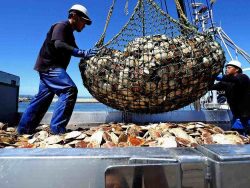15:50 JST, July 24, 2024
It has been shown that strict regulations on fish catches led to a steady recovery of resources. It is hoped that Japan, as a major fishing country, will play a responsible role in the international management of catches.
At an international conference to discuss resource management of Pacific bluefin tuna, it was agreed to increase the annual catch quota in response to the recovery of the resources. Japan’s quota for large Pacific bluefin tuna weighing 30 kilograms or more will be increased by 50% to 8,421 tons. The quota for the small fish was increased by 10% to 4,407 tons.
The agreement will be officially decided at a Western and Central Pacific Fisheries Commission (WCPFC) meeting to be held later this year. The quota for the large fish will be increased for the first time in three years, while that for the small fish will be raised for the first time since the introduction of restrictions in 2015. The increased quotas will be applied in 2025 or later.
Bluefin tuna is popular as a high-end sushi ingredient and as sashimi, and Japan is the largest consumer. An increase in the catches is also expected to lead to lower prices of these foods.
For the latest conference, Japan requested a 2.3-fold increase in the quota for the large fish and a 30% increase for the small fish. However, partly because some countries took a cautious stance, Japan’s requests were not approved as it had proposed. It is important for Japan to provide thorough explanations to gain the understanding of the countries concerned regarding the recovery of the resources.
For Japan, a country surrounded by the sea, balancing the use and protection of fishery resources is a serious issue.
Firstly, the stock of Pacific bluefin tuna was more than 100,000 tons at its peak in the 1960s, but it plummeted to about 10,000 tons in 2010. Overfishing by the Japanese side was the main cause.
To restore the stock, the WCPFC — an organization formed by Japan, the United States, South Korea, Taiwan and others — launched strict fish catch regulations in 2015.
The effects of these efforts have become evident. The organization had set a goal to bring the stock back to 130,000 tons by 2034, but it achieved that mark ahead of schedule at about 144,000 tons in 2022. This is noteworthy as a successful example of international fish catch regulations.
On the other hand, it is worrisome that there are many species of fish in Japan’s neighboring waters that have been suffering from record low catches in recent years. Japan’s entire catches of all species, including farm-raised fish, dropped last year to about 30% of its peak. Over the past 30 years, catches of saury and surumeika Japanese common squid have dropped by more than 90%.
Various factors have been pointed out as reasons for the decrease in catches for each species, such as rising sea temperatures and changing ocean currents, as well as overfishing mainly by fishers from various countries, making resource management increasingly difficult. The effects of international regulations on saury have yet to be clearly demonstrated.
What is important is to proceed with surveys of the situation regarding resources and to discuss regulations based on scientific evidence. It is hoped that the countries and regions concerned will share knowledge and map out measures for species that continue to have poor catches.
(From The Yomiuri Shimbun, July 24, 2024)
"Editorial & Columns" POPULAR ARTICLE
-

Violations of Subcontract Law: Major Automakers Must Eliminate Old Practices
-

Local Governments’ Tax Revenues: Devise Ways to Correct Imbalances in Tax Sources
-

Heavy Rains in Asia: Support for Victims, Flood-Control Measures Urgently Needed
-

5 Japanese Business Dinner Mistakes to Avoid — and What They Taught Me About Business in Japan
-

New Nuclear Threat: China Seeking to Follow U.S., Russia in Military Expansion
JN ACCESS RANKING
-

Japan’s Hopes for Seafood Exports Shot Down in China Spat
-

Keidanren Chairman Yoshinobu Tsutsui Visits Kashiwazaki-Kariwa Nuclear Power Plant; Inspects New Emergency Safety System
-

Japan to Charge Foreigners More for Residence Permits, Looking to Align with Western Countries
-

Imports of Rare Earths from China Facing Delays, May Be Caused by Deterioration of Japan-China Relations
-

Japan Exports Rise in October as Slump in U.S. Sales Eases




















